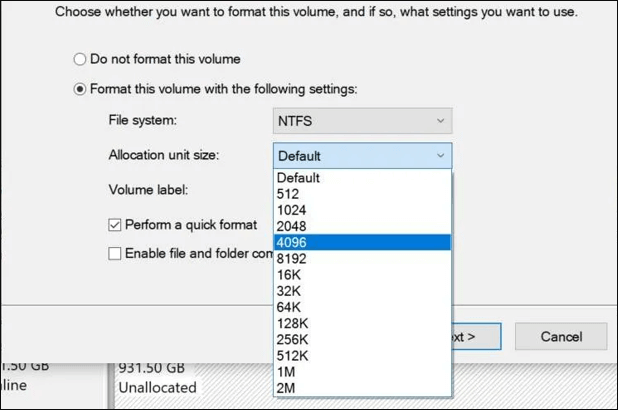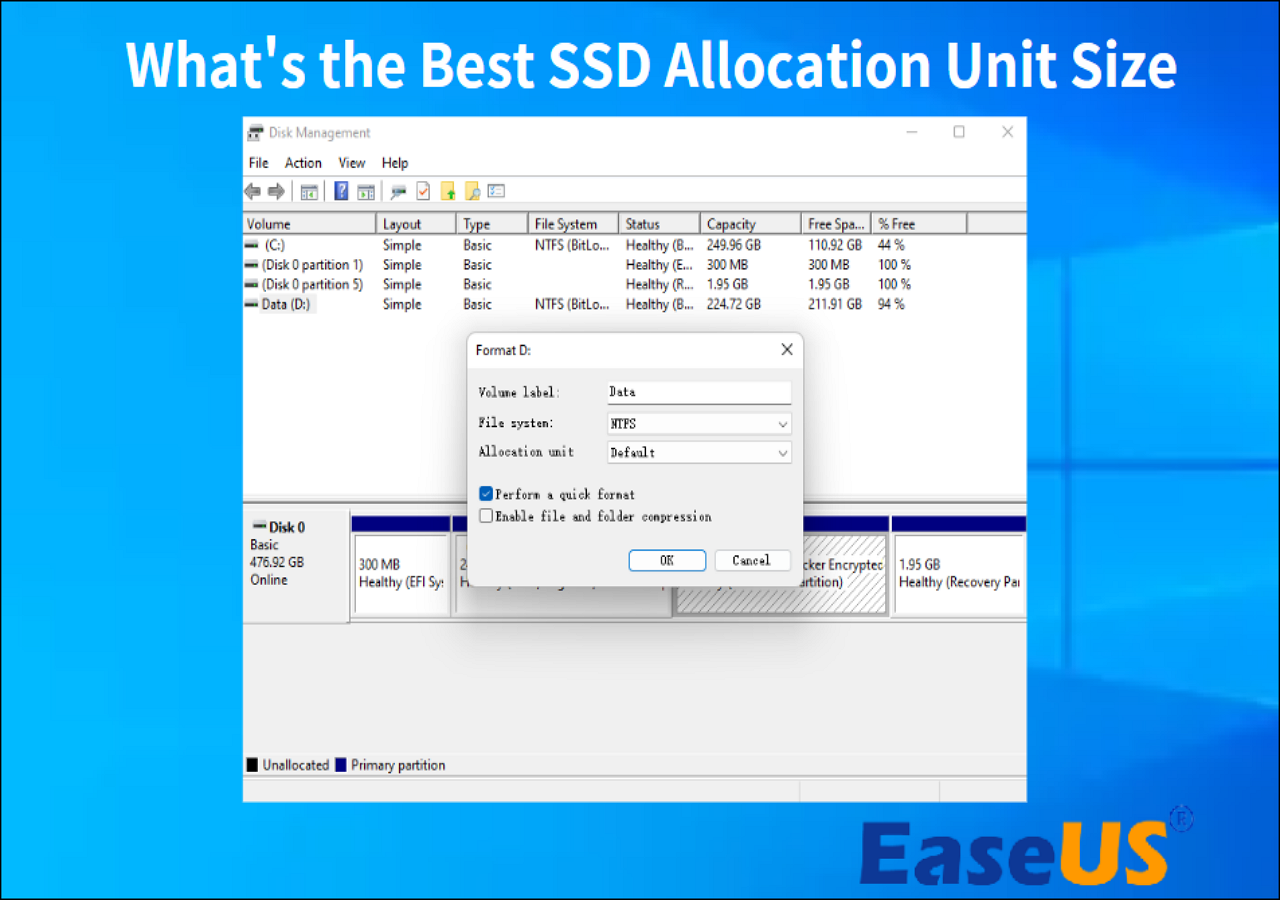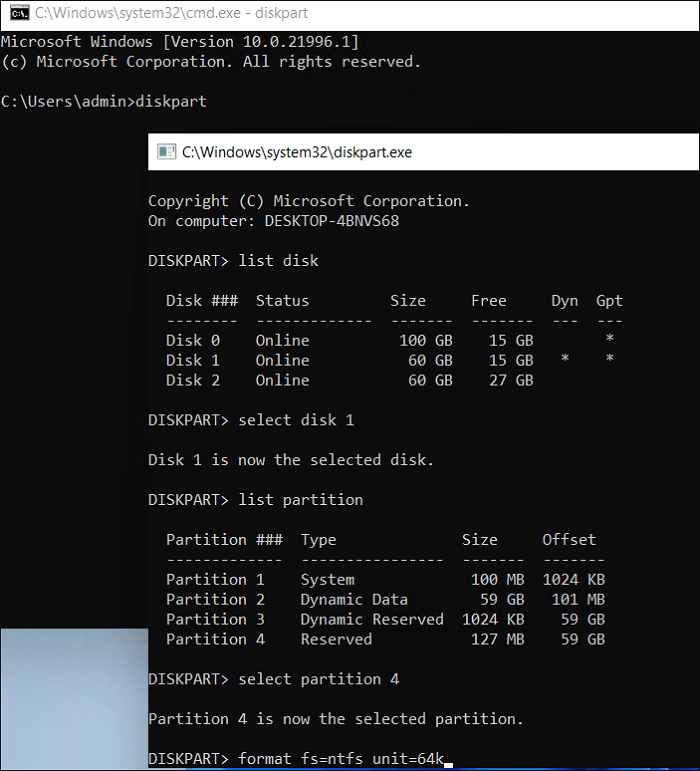You must read this article to know the answers to the questions above. So let's get straight to it!
What Means NTFS Allocation Unit Size
Your allocation unit's size will equal the size of an empty file. If you have several small files but a large allocation size, every file on your drive must be at least this huge, which could consume a lot of space on your hard drive. To utilize an extreme example, if you possess 1MB NTFS allocation size and 10 8KB files, each will consume 1MB. 10MB would be the entire drive space, not 80KB. Therefore, it can be seen that it's enough squandered space!
Usually, 4 Kilobytes is the most common NTFS allocation unit size nowadays. When you keep your allocation unit size small, a higher allocation time will be required, leading to a slower PC. However, it will take maximum disk space if it's too big.

You may also like:
What Is the Best NTFS Allocation Unit Size
Remember that if you fall under Microsoft's definition of a "Standard User," you should stick with the default 4096 bytes. However, the default criterion could be changed based on what you use them for in different partitions.
NTFS Allocation Unit Size for Movies:
You might select the 2MB maximum allocation unit size, but remember that this will result in smaller files (such as subtitle files) using the bare minimum of that space.
NTFS Allocation Unit Size for Images:
On the other hand, having a devoted drive to images and music might change things; for example, the music and image files are smaller than the movies. Hence, you may aim to keep the size of your allocation units below the size of your audio and video files.
For other knowledge about allocation unit size, such as the best SSD cluster size, please check the following article:
What's The Best SSD Allocation Unit Size in Windows 11/10
On this page, we will introduce what is the best SSD allocation unit size in Windows 11/10. And you can also get the best solution to change it.

How to Set NTFS Allocation Unit Size
While setting the NTFS allocation unit size, you must scan the given partition or drive and understand what's ideal for that particular one. In case it seems doubtful, you may leave it as the default. However, two possible ways are the following to change and reset the NTFS allocation unit size:
Method 1. Change NTFS Allocation Unit Size with EaseUS Partition Master
Do you know with the support of a professional partition manager, you can change the NTFS allocation unit size? That top-notch software is EaseUS Partition Master Free, an all-in-one free tool designed for every user.
Method 2. Change NTFS Allocation Unit Size with CMD
You may use the CMD command prompt to alter the NTFS allocation unit size for videos and games. Follow the steps below to change the NTFS allocation unit size with diskpart commands in CMD:
Step 1: To launch the run, hit window + R.
Step 2: To access the ongoing command prompt as the administrator, type " CMD " command and hit Ctrl + Shift + Enter.
Step 3: Hit "Enter" to open Diskpart.exe after entering the diskpart.
Step 4: Type the below-mentioned command, and keep pressing enter:
- list disk
- select disk * (the target disc's number is indicated by the *)
- list partition
- select partition * (the target partition's number is indicated by the *)
- format fs=ntfs unit=64k

Conclusion
After skimming through this article, you must have understood what NTFS allocation unit size is and how to set one with the help of two methods. What's more? You can easily complete this task using third-party software or a built-in Windows application.
Regarding EaseUS Partition, it cannot only modify cluster size without costing consumers anything, but it can also repartition hard drives and convert FAT32 to NTFS and NTFS to FAT32 without formatting or losing data, among other disc partitioning-related tasks.
FAQ About NTFS Allocation Unit Size
The FAQs about NTFS Allocation Unit Size are below to better comprehend the topic. If you have further problems, continue to read.
1. Does allocation unit size affect speed?
Yes. If the allocation unit size is too small, it may reduce your PC's speed. Moreover, allocation might take longer when more units are assigned to every file. However, if you make the allocation unit size too much, it will consume valuable disk space.
2. What allocation unit size should I use for the NTFS flash drive?
If your flash drive is bigger than 16GB, the most appropriate allocation unit size must be 16KB. However, the default cluster size for NTFS drives is 4KB for 7MB - 512MB, 512MB - 1GB, 1GB - 2GB, and 2GB - 2TB.
3. What will happen if the allocation unit size is large?
When you have different small files, it would be an amazing idea to maintain a minimum allocation size so that your hard drive space will stay manageable. On the other hand, when you possess several larger files, keeping the allocation size higher will boost the system's performance because there will be fewer blocks to aim for. However, if the allocation size is extremely big, it will consume the maximum of your PC's disk space.
Was This Page Helpful?
Cici is the junior editor of the writing team of EaseUS. She accepted the systematic training on computers at EaseUS for over one year. Now, she wrote a lot of professional articles to help people resolve the issues of hard drive corruption, computer boot errors, and disk partition problems.
Sherly joined EaseUS in 2022 and she has always loved writing articles and enjoys the fun they bring. She receives professional training here, focusing on product performance and other relative knowledge. She has written over 200 articles to help people overcome computing issues.
Related Articles
-
6 Ways to Fix Windows Update Not Working Windows 11/10
![author icon]() Cedric/2025-07-10
Cedric/2025-07-10 -
Access Denied When Copying Files Windows 10/8/7
![author icon]() Brithny/2025-07-07
Brithny/2025-07-07 -
How to Clean Install macOS Ventura [2025 Detailed Guide]
![author icon]() Jerry/2025-07-04
Jerry/2025-07-04 -
How to Fix 'Erase Assistant Is Not Supported on This Mac' Error
![author icon]() Dany/2025-07-04
Dany/2025-07-04
EaseUS Data Recovery Services
EaseUS data recovery experts have uneaqualed expertise to repair disks/systems and salvage data from all devices like RAID, HDD, SSD, USB, etc.